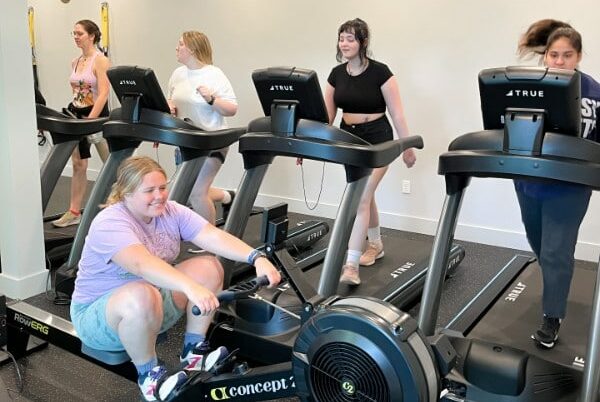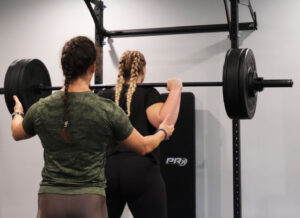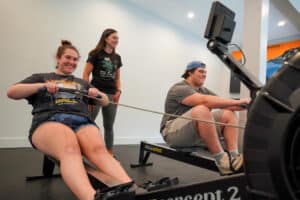CARDIO. It’s a term that gets thrown around quite often in the fitness industry, and for many, this term conjures up memories of hours spent on sweaty treadmills, stair steppers, ellipticals, or bikes. While cardio, short for cardiovascular or relating to the heart and lungs, might encompass this equipment, it’s essential to understand why this component of fitness can help boost your overall health and wellness, as well as what efficient cardiovascular training can look like.
At Skyterra Young Adult, cardio is built into the weekly schedule in a smart and intentional way to help our guests discover options that not only work for them, but that they enjoy.
What is Cardiovascular Fitness, and Why Do We Need it?
Cardiovascular fitness is the body’s ability to shuttle oxygen breathed in through the lungs to working muscles. Oxygen is an important component in producing energy and fuels our longer-lasting movement. When moving with higher intensity, more oxygen is needed, and the heart beats faster to pump more oxygen through blood vessels to the target muscles. Due to the heavy need for oxygen to make this process work, cardiovascular work is also called aerobic (in the presence of oxygen) exercise.
Aerobic exercise encompasses any activity that gets your heart and lungs pumping for an extended period of time. Common examples of exercises used for cardiovascular exercise include brisk walking, jogging or running, swimming, biking, hiking, and more.
The American Heart Association recommends that adults aim for 150 minutes (two and a half hours) per week of moderate to vigorous aerobic activity. A common breakdown could be 30 minutes a day, five days a week. Or add in three 10-minute movement sessions throughout the day.
An individual’s level of cardiovascular fitness has been shown to relay benefits beyond running, walking, or your-favorite-activity-ing well. The American Heart Association specifically highlights the role of aerobic exercise in reducing the risk of heart disease, stroke, and diabetes. In addition, cardio can help improve the overall function of the lungs, heart, and circulatory system. Regular use of cardiovascular exercise can lower resting heart rate and blood pressure, increase cognitive function, improve sleep, manage weight and boost immune system function.
The benefits of cardiovascular activity extend to the mind as well. Studies show that 30 minutes of cardio three times a week improves self-esteem and cognitive function while reducing anxiety, negative mood, and depression. In a world where young adults are increasingly experiencing more and more of these mental backdrops, cardio can be a helpful addition to one’s mental health regimen.
At Skyterra Young Adult, we include cardiovascular activity throughout the day and week. Mornings always start with intentional movement, which we’ve found sets the stage for positivity and focus throughout the day. Campus walks are a part of our daily routine to aid in post-meal digestion, boost our focus, and enjoy our tranquil mountain surroundings. Surrounded by a major national park and renowned state forest, we frequently head off campus to hike and enjoy time in nature while reaping the benefits of cardio, too! Cardio also features as a part of our morning workout routine 1-2 days per week where guests have the opportunity to engage in smart and challenging cardio routines that are tailored to the needs and preferences of our guests. While challenging, we’ve found that conquering these workouts boosts confidence and self-esteem that our guests then carry with them to their therapeutic work.
How do I Get Started?
With all the benefits cardiovascular exercise offers, it’s tempting to want to jump right in! However, there are different levels of cardiovascular intensity, and tapping into a specific amount of each type can greatly enhance the benefits one reaps from physical activity.
Programming at Skyterra emphasizes the majority use of MAF (Max Aerobic Function) or LISS (Low-Intensity Steady State) cardio, while a smart and selective sprinkling of high-intensity cardio training to reap the most benefits. See below for how we use different approaches to cardio fitness to build strong and confident young adults.
MAF and LISS
Developed by Dr. Phil Maffetone, MAF invites exercisers to work at a lower heart rate zone. Through studying heart rate data, Dr. Maffetone noticed that the most benefits of cardio could be reached with minimal strain on the body when working at or under a specific heart rate.
At Skyterra Young Adult, we determine heart rate goals for each guest based on Dr. Maffetone’s work. For example, if a guest is 21 years old, their goal would be to stay within 149 to 159 beats per minute to obtain the maximum benefit from MAF training. To determine your own MAF training zones, check out this article.
LISS (Low-Intensity Steady-State) cardio is similar to MAF in that the focus is on going slower with a lower heart rate. LISS differs in that the target heart rate zone is 50 to 70 percent of one’s max heart rate, which is often slightly lower than what is used for MAF. Going back to our 21-year-old guest, we might find her max heart rate by subtracting her age from 220 (the most common formula used to calculate max heart rate). By multiplying by the desired percentages, we’d find that her heart rate zone for LISS would be 100 to 139 bpm.
At Skyterra the use of both MAF and LISS allows for a greater range of activities and intensities while giving guests a tangible low-intensity goal to aim for, regardless of fitness level. Our weekly and weekend hikes and campus walks are our main integration of MAF and LISS. This allows us to enjoy the great outdoors and healing power of nature while also building our cardiovascular system.
Guests learn how activities of daily living often cross over into LISS, too. Gardening, walking up and down the stairs, housework, and more tend to elevate heart rate response to yield these low-intensity benefits.
For some guests, a weekend hike may be a MAF workout and a LISS effort for others. The effects of both MAF and LISS are very similar, and a workout does not need to be exclusively one or the other to see benefits. Both contribute to overall capillary development in working muscles, an increase in aerobic fitness and utilization of fat as energy, and improved mitochondrial function.
Both allow for all of these benefits with minimal stress on the body, which lowers one’s chances of burnout and injury. LISS often allows for the integration of activities of daily life (i.e. walking to the store, pushing a shopping cart, gardening, etc.), which shifts focus back to not just exercise, but overall daily movement in general.
While heart rate-based training can be super informative and helpful, it isn’t the only way to determine exercise intensity. Many guests come to Skyterra Young Adult to take a break from technology, which can include watches or devices that measure heart rate. And, some guests prefer keeping technology out of their fitness routine, which is a-okay too! The good news is that there is a strong correlation between breathing exclusively in and out through the nose and MAF heart rate intensity. So, if one can comfortably breathe in and out through their nose during a walk, run, paddle, etc., or is able to keep up a conversation without getting out of breath, there’s a very good chance it’s a LISS or MAF effort!
The Truth Behind Moderate-Intensity Exercise
If low-intensity is good, moderate intensity must be better, right? Actually, it is not.
Moderate-intensity is where most exercisers end up during a cardiovascular effort, as it typically feels like a challenging effort that can be held for a longer duration. Extended time spent here leads to a greater secretion of stress hormones in the body as well as being a greater stress on the muscles, bones, and ligaments.
At Skyterra Young Adult, we call this zone the mushy middle. Most guests discover that they’ve spent a fair amount of time here in the past, and can connect feelings of burnout or injury with these time periods. These efforts take longer to recover from than low-intensity work and do not yield the same level of benefits as high-intensity work. Training with mainly moderate-intensity work will yield minimal benefits with maximum risks (slower recovery, more stress on the body, more stress hormones).
It is inevitable that at some point during a workout, heart rate may pass through this zone, especially for endurance athletes. However, limiting time here will yield the most benefits. At Skyterra, we keep low-intensity low by encouraging conversation on hikes and walks, and setting the expectation that guests listen to their bodies and break when needed. During high-intensity efforts, we challenge our guests to showcase their best efforts, while taking adequate rest and recovery in between through breath cues, posture, and watching for signs of form breakdown and fatigue.
The mushy middle is found by looking at the range between the top number of MAF and the bottom number of high-intensity training. Our 21-year-old guest’s range would be between 159 to 174 bpm. If not using a heart rate monitor, check out your breathing again! This zone typically allows us to breathe in through the nose and out through the mouth comfortably. Nose-nose breathing would feel like a challenge, and it’s not difficult enough to have to breathe exclusively in and out through the mouth.
High-Intensity Work Benefits the Body
While training at lower intensities is important, there are benefits that come with training at one’s highest levels. High-intensity training calls for working at near maximal effort for a short burst of time. This is often seen as interval work: giving the body a set amount of time or distance to accomplish with enough rest and recovery in between efforts so that the next effort can be just as challenging.
High-intensity work benefits the body by temporarily boosting metabolism, increasing mitochondrial density, improving insulin sensitivity, and improving both aerobic and anaerobic energy systems. In addition, this type of training is shorter and more efficient and adds variety to weekly workouts.
At Skyterra Young Adult, 1-2 workouts per week highlight high-intensity cardio. We use a variety of modalities and interval structures, some of our favorites being Tabata (work hard for :20, recover for :10 for eight rounds), and structured intervals (i.e. 2 minutes hard, 1 minute easy). We might take efforts outside, or utilize treadmills or rowers. Or, we’ll incorporate conditioning or plyometric movements like lunges or box jumps to provide variety and a different challenge for the body. Our hope is that by introducing a variety of high-intensity styles, guests can decide which works best for their bodies and have a better idea of what high-intensity cardio can look like back home.
Our high-intensity zone can be found by adding 15 bpm to the top end of the MAF zone. For our 21-year-old guest, that would be 174+ bpm. Again, if no heart rate monitor is available, look at breathing! This effort usually requires a mouth-mouth breath.
How Do I Set Up My Week?
Cardio doesn’t need to take a lot of time or be super intense to make a big impact on one’s health and wellness. In general, three to five 30-60 minute sessions will yield benefits.
At Skyterra Young Adult, we have four structured workouts each week, with high-intensity cardio accounting for 1-2 of those days. This allows our guests to bring their best efforts forward with ample recovery time in between. Low-intensity work takes place outside of the gym to model for our guests a realistic and holistic cardiovascular activity integration. Our campus walks, hikes, wood-gathering walks, dance parties, grocery store trips and more show our guests how cardio can fit into their days at home, and need not be one more thing to check off their to-do lists. Once our guests return home, we recommend continuing to follow that model with mostly low intensity (LISS or MAF) and a sprinkling of one to two high-intensity workouts per week. For those newer to exercise, starting out with shorter, lower intensity sessions is a great way to start building stamina and confidence while reducing the risk of injury.






